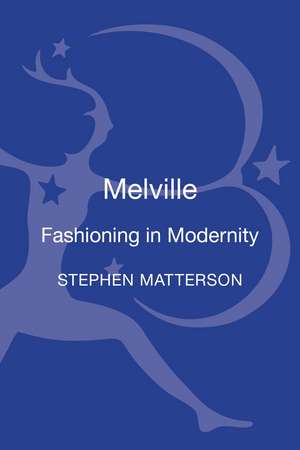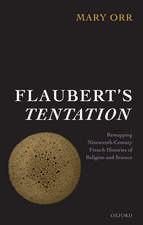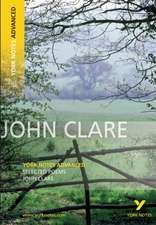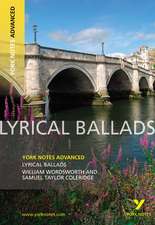Melville: Fashioning in Modernity
Autor Prof. Stephen Mattersonen Limba Engleză Hardback – 24 sep 2014
| Toate formatele și edițiile | Preț | Express |
|---|---|---|
| Paperback (1) | 190.96 lei 6-8 săpt. | |
| Bloomsbury Publishing – 24 sep 2014 | 190.96 lei 6-8 săpt. | |
| Hardback (1) | 713.72 lei 6-8 săpt. | |
| Bloomsbury Publishing – 24 sep 2014 | 713.72 lei 6-8 săpt. |
Preț: 713.72 lei
Preț vechi: 914.15 lei
-22% Nou
Puncte Express: 1071
Preț estimativ în valută:
136.57€ • 146.04$ • 113.87£
136.57€ • 146.04$ • 113.87£
Carte tipărită la comandă
Livrare economică 17 aprilie-01 mai
Preluare comenzi: 021 569.72.76
Specificații
ISBN-13: 9781623563677
ISBN-10: 1623563674
Pagini: 240
Dimensiuni: 140 x 216 x 23 mm
Greutate: 0.43 kg
Ediția:New.
Editura: Bloomsbury Publishing
Colecția Bloomsbury Academic
Locul publicării:New York, United States
ISBN-10: 1623563674
Pagini: 240
Dimensiuni: 140 x 216 x 23 mm
Greutate: 0.43 kg
Ediția:New.
Editura: Bloomsbury Publishing
Colecția Bloomsbury Academic
Locul publicării:New York, United States
Caracteristici
Covers the major fiction as well as relatively neglected works like Redburn and Israel Potter
Notă biografică
Stephen Matterson is Professor of English Studies and a Fellow of the College at Trinity College, University of Dublin, Ireland. He is the author or editor of nine books and over sixty articles, essays and reviews on aspects of US literature. His past publications include the Penguin Classics edition of Herman Melville, The Confidence-Man (edited with an Introduction and Notes, 1990); American Literature: The Essential Glossary (2003); the Wordsworth edition of The Complete Poems of Walt Whitman (edited with an introduction and notes, 2006); and Studying Poetry (with Darryl Jones; 1st edition, 2000; updated and enlarged second edition, 2011).
Cuprins
Introduction: Herman Melville's blue-jean careerChapter One: So unspeakably significant: Melville, Hawthorne and the shawlsChapter Two: A very strange compound indeed: Carlyle, Redburn and White-JacketChapter Three: He was an European, and had Cloaths on: Typee.Chapter Four: The dress befitted the fate: Israel Potter's LivesChapter Five: These buttons that we wear: Billy Budd
Recenzii
[The] dress-theme proves a fresh and remarkably fertile approach to Melville's prose, and is the basis both for new insights into individual works and for a novel consideration of the broader development of his writing career. ... Matterson's keen eye for detail and parallels, the scholarly rigor of his research and his entertaining writing style draw the reader into a considered and multifaceted portrayal of Melville and an elaborate exploration of the symbolic aspects of dress and clothing. The individual chapters provide stimulating starting points for a study of individual works, whereas the book as a whole offers a fresh and novel meditation on Melville as an author. As such, the book will be valuable to a range of readers, from undergraduate students looking for readings of individual works, to graduate students looking for inspiration for research topics and to anyone else who has a particular interest in Melville.
Few novelists have treated dress so seriously: expressive or repressive, puzzling but rarely pleasurable, Melville's fictional clothes are hostages to fortune in an uncertain world. Literary and dress studies are indebted to Stephen Matterson's insight into this important usage of dress and for drawing our attention to it in his book in so original and stimulating a way.
Matterson (Trinity College, Univ. of Dublin, Ireland) studies articles of dress in Melville's works, especially the correspondence between clothes and identity. The first chapter repeats the speculation of Melville scholars Merton Sealts Jr. and Hershel Parker that Melville may himself have written the so-called Agatha story he suggested Nathaniel Hawthorne use and may have been unable to publish the finished work, possibly the lost Isle of the Cross mentioned in letters. Matterson focuses on relatively minor works: Redburn, White-Jacket, Israel Potter, and Typee. He refers to the major works only in passing until the last chapter, which details the problems scholars encounter in producing any version of Billy Budd because Melville left it unfinished. Attempting to produce a readable text, early editors distorted the work by making choices Melville did not authorize. Melville's alterations suggest he intended to shift interest from the conflict between Billy Budd and John Claggart to the internal struggle within Captain Vere. There is not really enough on clothes in Melville to merit a book-length study of interest to scholars, but less-experienced readers can learn much from this work because it summarizes and synthesizes previous Melville scholarship in quite readable form. Summing Up: Recommended. Lower- and upper-division undergraduates.
Melville: Fashioning in Modernity is a somewhat unusual book, and a rather great one at that ... [I]t manages to deliver a concise and lucid study of a respectable academic topic, as well as draw attention to the less-illuminated aspects of Melville's universe and works that are, to put it simply, begging to be studied ... A perfect combination of well-researched basics, exciting details and multitudinous opportunities for further enquiry.
A delightful and learned examination of the role played by clothing in various works by Herman Melville. Matterson sews a new suit for Melville. He shows us through his finely-stitched and delightfully-measured prose how clothing covers issues of identity, power, modernity, and rebellion in Melville's work - often in illuminating fashion.
Literary and dress studies are indebted to Stephen Matterson's insight into this important usage of dress and fordrawing our attention to it in his book in so original and stimulating a way.
Few novelists have treated dress so seriously: expressive or repressive, puzzling but rarely pleasurable, Melville's fictional clothes are hostages to fortune in an uncertain world. Literary and dress studies are indebted to Stephen Matterson's insight into this important usage of dress and for drawing our attention to it in his book in so original and stimulating a way.
Matterson (Trinity College, Univ. of Dublin, Ireland) studies articles of dress in Melville's works, especially the correspondence between clothes and identity. The first chapter repeats the speculation of Melville scholars Merton Sealts Jr. and Hershel Parker that Melville may himself have written the so-called Agatha story he suggested Nathaniel Hawthorne use and may have been unable to publish the finished work, possibly the lost Isle of the Cross mentioned in letters. Matterson focuses on relatively minor works: Redburn, White-Jacket, Israel Potter, and Typee. He refers to the major works only in passing until the last chapter, which details the problems scholars encounter in producing any version of Billy Budd because Melville left it unfinished. Attempting to produce a readable text, early editors distorted the work by making choices Melville did not authorize. Melville's alterations suggest he intended to shift interest from the conflict between Billy Budd and John Claggart to the internal struggle within Captain Vere. There is not really enough on clothes in Melville to merit a book-length study of interest to scholars, but less-experienced readers can learn much from this work because it summarizes and synthesizes previous Melville scholarship in quite readable form. Summing Up: Recommended. Lower- and upper-division undergraduates.
Melville: Fashioning in Modernity is a somewhat unusual book, and a rather great one at that ... [I]t manages to deliver a concise and lucid study of a respectable academic topic, as well as draw attention to the less-illuminated aspects of Melville's universe and works that are, to put it simply, begging to be studied ... A perfect combination of well-researched basics, exciting details and multitudinous opportunities for further enquiry.
A delightful and learned examination of the role played by clothing in various works by Herman Melville. Matterson sews a new suit for Melville. He shows us through his finely-stitched and delightfully-measured prose how clothing covers issues of identity, power, modernity, and rebellion in Melville's work - often in illuminating fashion.
Literary and dress studies are indebted to Stephen Matterson's insight into this important usage of dress and fordrawing our attention to it in his book in so original and stimulating a way.













